Before I talk about Lifeless Planet, I’d like to share a funny story. I was talking with a coworker the other day and for some reason the conversation turned to space, specifically how big it is. Now, before I go on, you need to understand that I work with some people who are… rather… narrow… in their thought processes. Which is why, at this point, my colleague said:
“Well, they don’t know for sure that space is that big. I mean, they can’t say the distance for fact without actually measuring it.”
I stared at him.
| ME | ||
| You mean like, with a… like with a tape measure? | ||
| – | ||
| HIM | ||
| Of course not. I’m just saying they can’t know the next star is whatever light years away. | ||
| – | ||
| ME | ||
| I’m pretty sure they can. | ||
| – | ||
| HIM | ||
| They can’t. | ||
| – | ||
| ME | ||
| I’m pretty sure they can. | ||
| – | ||
| HIM | ||
| They can’t. How could they possibly measure that? | ||
| – | ||
| (At this point, I admit my own knowledge of the universe does break down slightly. But I believe history will show me to be on the side of right in this.) | ||
| – | ||
| ME | ||
| Okay, you are aware of this thing they have called “science.” | ||
| – | ||
| HIM | ||
| Science is just a theory. The distances in space are theories, they can’t prove them. | ||
| – | ||
| ME | ||
| I’m pretty sure they can. | ||
| – | ||
| HIM | ||
| Yeah? How? | ||
| – | ||
| ME (Exasperated) | ||
| Redshift! Fuck, I don’t know. Gravitational lensing! What, you won’t believe the next star over is four light years away until somebody clears their odometer and drives it? | ||
| – | ||
| HIM | ||
| It might be four light years away. But they have no way of knowing for sure. | ||
| – | ||
| ME | ||
| I’m taking charge of your children’s education effective immediately. |
Consider – assuming you believe in them – the vast, incomprehensible distances of space; the madness-inducing immensity it contains. In Ben Bova’s novel Mars, a character on a spacewalk simply drops dead because he is so overpowered by the horror of the void, the yawning abyss, with him inside it, cowering in naked insignificance as the Martian moon Deimos looms before him. Later a character acknowledges that it was a heart attack but then says, “He died of Deimos. Of dread.”
Now imagine the sacrifices to be made by the first human explorers of that forbidding expanse. The interplanetary ones who will sacrifice their bones to weightlessness and DNA to cosmic rays as they make the eight-month trip to Mars. The interstellar ones who will sacrifice everything – home, family, the cradle of humanity itself – as they leave this solar system and venture beyond.
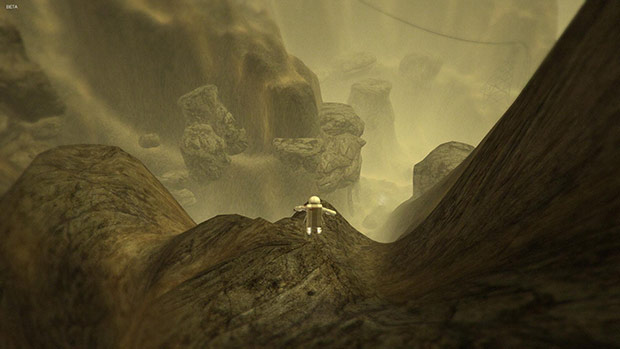
Commanding the first manned mission to an extrasolar planet, you will be immortal, to be sure. Your name and the names of your crewmates will be remembered forever, until the very end of the human story, as the first to ever walk on a world that has never known the light of our sun. Naturally it will take years in cryosleep, even at light speed, to reach it, and of course there’s no provision at all for a return to Earth. It is a one-way trip.
But you have little holding you on Earth (“few attachments,” says your character in a voiceover interview that’ll become, I suspect, a main narrative element). Another world, in another solar system, watched over by another star. Terrestrial scans show verdant plant life but no evidence of intelligence. With luck you should be able to do well there for years, maybe more.
So what do you do upon waking up after a not-quite-crash-but-definitely-bumpier-than-expected landing and find your crew gone? Your surroundings not lushly vegetated but barren and desiccated, devoid of plants, of water, of air?
That’s not the horrible part. That you’re going to die here within hours is just a pity. You knew you’d die here, a price you paid in exchange for the opportunity and the immortality. But take away the immortality, and the nightmare truly begins. What do you do, how do you react, when you discover that you’re not the first to arrive? That humans have been here for years?
Welcome to Lifeless Planet, a game not about exploration, but about the appalling sacrifices made by the explorers.
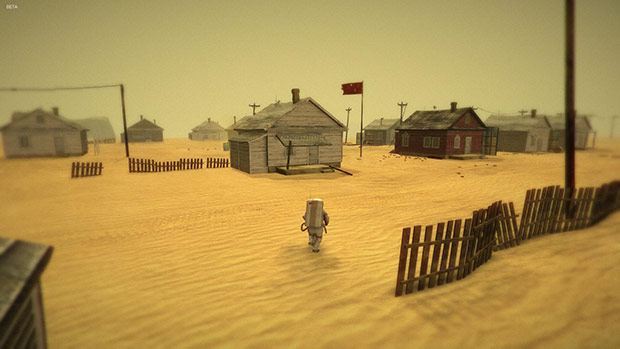
Must’ve hit my head harder than I thought during the landing.
I bought Lifeless Planet on Steam Early Access despite my profound concerns about that service. This was a Kickstarted game, if I recall correctly, and I do have some memory of looking at the Kickstarter pitch and deciding not to back it. I make a habit of not backing Kickstarters that are already fully funded, which must have been the case here. Given how up my alley the basics of Lifeless Planet are, there’s no other reason I wouldn’t have put in a few bucks. But I’d forgotten all about the game until Alec Meer shared his thoughts on it over at Rock Paper Shotgun. Meer convinced me to buy it – in fact, he convinced me to go buy it that instant.
He did this not by raving but by finding fault. Despite explicitly not warning anyone away from the game (quite the opposite), Meer’s article was a devastating litany of everything I also tend to despise – twitchy controls, precision jumping, constant death by falling, occasionally dense puzzles. Worse, he said flat-out that ongoing developing and tuning can’t address these issues, because they’re the foundation of Lifeless Planet. And then he said despite it all he couldn’t stop thinking about the game. Which became understandable to me in a matter of minutes.
It is visually… it is… it is remarkable. You have to see it. It’s haunting. It’s simultaneously horrifying and beautiful, dreamlike in a way that usually only dreams are despite our using the term “dreamlike” to describe all kinds of stuff that really isn’t. David Board, the one-man show that is Stage 2 Studios and Lifeless Planet, has created something unutterably unique, stunning, the kind of game that would never exist if it weren’t for Kickstarter.
Within the first four minutes, Lifeless Planet is cruel.
Coming to on the barren, windswept surface is weird. It means someone – presumably your crew – took you out of the landing pod. But the crew is now unaccountably absent. In a display of what I can only classify as monumentally foolish optimism, you decide that they’ve gone off to “set up a perimeter.” All of them. Leaving you alone. Unconscious. Concussed. On your back in a spacesuit on a windswept dune. Without a note that says gone to set up perimeter back soon. You’re still processing that when your bulky, NASA-issue spacesuit springs a leak.
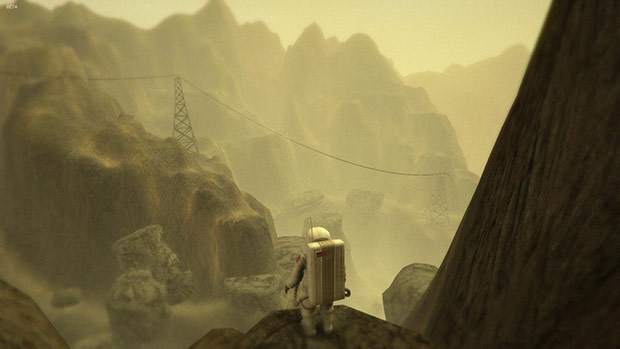
The planet has no air (it was supposed to have air) and no life (it was supposed to have life) and the only possible hope for repairs is the busted, smoke-billowing landing capsule. But the deft first moments show uncanny grasp of how people react to situations, and how that can be parlayed into level design that teaches but also makes a point. I did what most people, I suspect, will do: I set off at a spacesuit-limited trot, following what looked a little like a trail of footprints, the hissing from my suit’s hose my sole companion.
A little later as my vision darkened, I turned back. What had I been thinking? That there’d be an air store over the next rise? Of course not. The landing capsule, obviously, was my only hope. But the moment I turned, I realized I’d gone too far. So I turned around again. Maybe there was something further on. As the periphery grew more cloudy still, I panicked and doubled back once more.
This is why people die in the snow, and it’s how I died the first time in Lifeless Planet. It works. You learn a certain lesson about where you are and what you can expect.
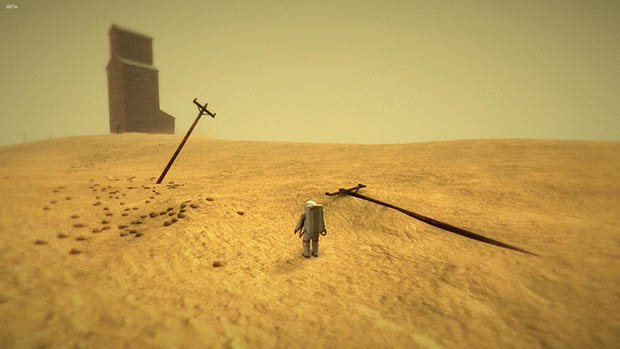
That’s… that’s an odd rock formation.
It’s cruel but not overly so. Make up your mind, it’s saying. Next time I just kept going, and… what the hell…?
Welcome to Lifeless Planet.
To Alec Meer’s comments about the falling deaths and persnickety jumps: he’s right. From one point of view, that’s all Lifeless Planet is. This is a puzzle platformer, pure and simple. It’s jumping, rock-rolling, manipulating mechanical arms. But all these puzzles are secondary to the actual mystery of Lifeless Planet, one so tantalizing and so eerie, so frightening in its implications, that I can’t really guess where it might be going and I’m dying to find out.
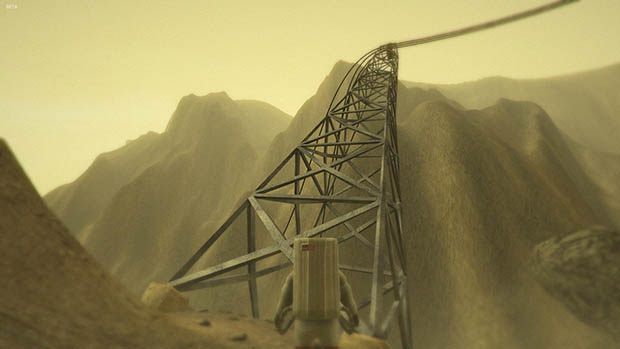
Yeah. So… this happened.
Persnickety though it may be, the platforming it didn’t bother me nearly as much as it bothered Meer, chiefly because – thanks to him – I went in knowing to expect it. I don’t mind platformers if I know that’s what I’m getting into, and none of the puzzles (so far) in Lifeless Planet are that fiendish. I found that a 360 controller readily addresses control issues that would bedevil the game otherwise. Movement physics can be tougher to get used to. You move like you’re in a big bulky spacesuit, because you are. Gravity’s slightly different on this world too, meaning that jumps feel funny until you mentally recalibrate and plan accordingly.
But don’t approach Lifeless Planet with any presuppositions beyond this: it’s a platformer, through and through. It had to be something. You have to put a game in the game. The idea of this game is brilliant, and that brilliance is brilliantly realized (my God, some of the things you see), but an idea and a bunch of visuals do not a game make. I suppose Stage 2 Studios could have made Lifeless Planet a shooter, or RPG, but offhand I’d say it works best as a platformer. That format is about getting from A to B with obstacles in between, which suits both the physical and figurative objectives of Lifeless Planet.
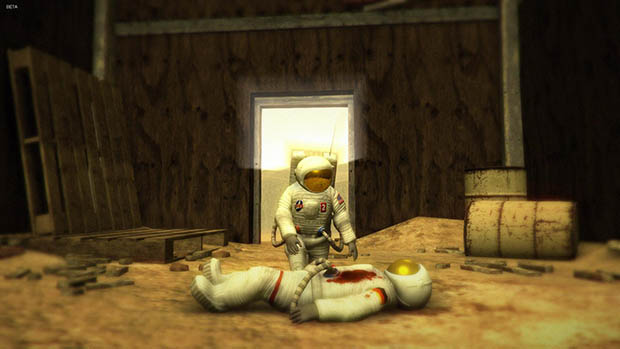
Not what it looks like. Nothing is.
Shades of Tarkovsky echo throughout the game – indeed, a working knowledge of Russian language, cinema, and literature might come in handy – but I don’t think Lifeless Planet is just a gameified retelling of Solaris or anything like that. To be honest, I haven’t got a clue where the story is going. The mission commander’s emotional journey will likely have more prominence in the final release; it’s only hinted at in this Early Access content. As to what the planet is, where you are, what’s happened – what continues to be happening – in this place, well, it’s my understanding that the game is heavily influenced by a Russian novel, but I don’t know which one, or what it’s about. Still, though, there’s more to it. I think there’s more to it. I hope there’s more to it.
Lifeless Planet is the consummate indie. Even more than Consortium, it’s the kind of game that only an independent could make, and (more gratifyingly) it’s the kind that remembers it’s a game first. Lifeless Planet is arty and odd without being Lynchian or falling into the “we don’t make games that are fun” trap fashionable among the aggressively independent. Actually it’s a lot of fun. The puzzles are fun to solve, and the way you get to solve them is cool too. It introduces mechanics slowly without making the dripfeed into a chore; it gives you things you love and then takes them away, which makes you sad, but not too sad. You never feel cheated. It’s a fun game to play.
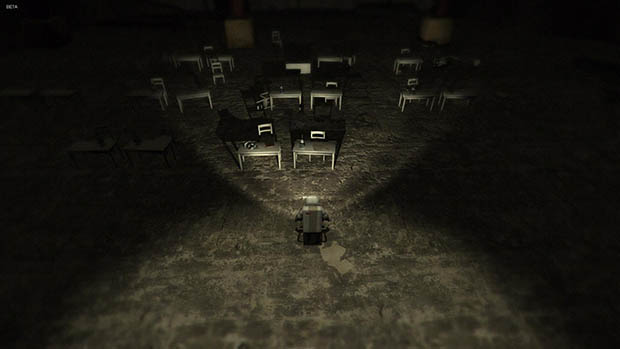
Spoiler! It’s actually a pretty life-ful planet. Kind of.
The past few years have seen a bloom in independents beyond anything we’d have though possible a decade past. Many things have contributed to this, but arguably the most important of them isn’t Kickstarter, or Early Access, it’s Unity. Practically every independent game you’ve got your eye on is powered by Unity, except for the ones where they’re building their own engine. The thing is, Unity isn’t some cut-rate, obviously cheap codebase. Unity can do basically anything, and Lifeless Planet makes very good use of it. Stage 2 has some polish left to do – clipping here and there, some camera stuff, nothing major – but one reason I can happily recommend it is that you’re not getting the usual Swiss-cheese alpha Early Access is known for. David Board elected to do what’s called a “vertical slice” – basically a functionally complete but content-limited chunk of the game. So instead of a beginning, middle, and end with placeholder graphics and missing areas and no UI and so forth, you get the first two hours or so of the game more or less as it’ll be when it ships.
Because of this I can tell that Lifeless Planet is well put together, that it has good, simple UI and excellent controller integration, that the gameworld is going to look and behave so. There won’t be surprises. With most Early Access games you get a mess of half-done features. That’s not inherently wrong – it’s how games are made – but the problem with Early Access is that normally you’re paying for the promise of something, with no guarantee that you’ll ever get it. With Lifeless Planet, I paid twelve bucks and got a fantastic, though very short, complete game. Later I’ll get a much longer game but one that’s fundamentally the same.
Lifeless Planet is lonely exploration and environmental puzzle solving. That’s not likely to change, so if you’re an opponent of the new “walking around” games we’re seeing, the ones popularized by Dear Esther, avoid this. But if you’re okay with just walking around, Lifeless Planet is going to offer you some of the most haunting, striking, remarkable moments you’ve had in a very long time.
![]()
Point out that Steerpike didn’t actually say much about the game by clicking here.


See, but Dear Esther was ALL walking. There wasn’t jumping or puzzling! (Or dying.)
You know, Steerpike, with the number of lonely, existential games you’ve been impressioning and reviewing this last little while, I feel slightly compelled to express concern for your health.
Lonely and existential is my middle name!
Dear Esther differs from Lifeless Planet I. another key way too: the latter appears to have a linear narrative with a somewhat normal arc. Based on the first two hours of the game, the promised promised six to ten will actually tell a story that’s only open to interpretation in the way normal stories are, rather than in every way possible like Dear Esther’s. I’m still generally a defender of that game, but in fairness to this one, I should retract the comparison. Lifeless Planet has more in common with Journey than with Dear Esther, though it’s also too early to say whether it’ll be the soul-buffing transcendental extravaganza we associate with ThatGameCompany’s recent work.
This is the first I’ve heard of this game and it looks very interesting. It does remind me of Journey a bit. I’m not a fan of platforming, but I love the exploring part of it.
I’m looking forward to this game now, but I’m not too keen on paying for early access now. Only game I’ve ever got before release was minecraft.
On stars: The distance from here to any star is very easy to calculate with 12 grade math. It’s called triangulation: http://en.wikipedia.org/wiki/Triangulation#Distance_to_a_point_by_measuring_two_fixed_angles
Because of the distances involved the confidence interval are very big, but it’s not like we’re ever going to find out the stars are two moons away or something silly like that.
I don’t pay for early access either, since there are so many other games in my queue, but I agree that this game looks pretty cool indeed. One to watch!
Sounds like an interesting title. The mystery appeals; not so much the puzzle platforming.
I wonder if they’ll amend their astronaut model now that NASA have announced their new space suits? 😉
Oh, and you might want to give Outer Wilds a go. Not sure if you’ve come across it before but it’s quite the science fiction adventure.
“Lonely and existential is my middle name!”
Laugh out loud!
“soul-buffing transcendental extravaganza”
Laugh out loud! (sorry)
Great write-up Steerpike and definitely one I’ll keep an eye out for. I remember seeing it some time ago and, yeah, while the visuals are ‘sparse’ (they look like macro photos of miniature models), they’re really quite beautiful at the same time and evocative.